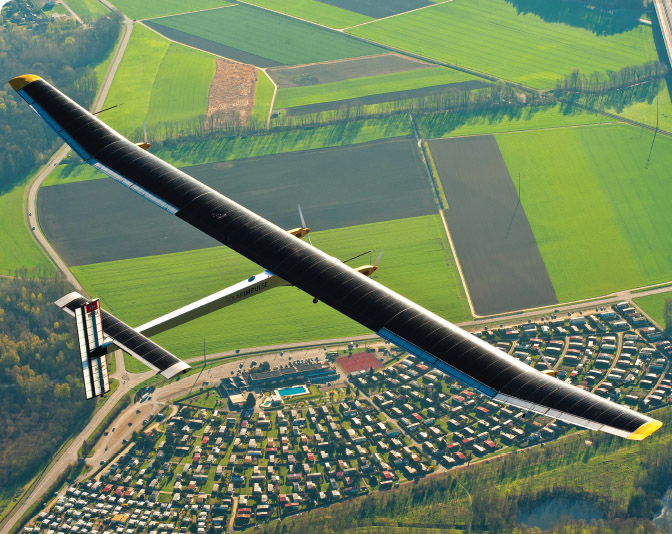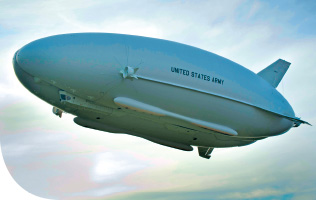October 2012 – First Look
Icarus Redeemed
Two years ago, the Solar Impulse became the first solar-powered airplane to fly 26 hours nonstop. Now the Swiss-made craft has chalked up another record. This summer, it became the first sun-fueled aircraft to complete a trans-Mediterranean flight, covering around 3,100 miles from Payerne, Switzerland, to Rabat, Morocco. It was piloted by former balloonist Bertrand Piccard and André Borschberg, who together conceived the plane in 2003. Although the Solar Impulse has a wingspan equal to an Airbus A340, it weighs only about as much as a standard car. That’s because it’s made from lightweight carbon fiber materials. Some 12,000 solar cells in its wings feed energy to four 10-horsepower motors. Power stored in lithium batteries during the day permits night flying. En route back to Europe, the plane averaged a speed of around 37 mph during a 560-mile leg between Morocco and Spain, and had to slice through even stronger crosswinds. The team now plans to build an updated version of the Solar Impulse to tackle an around-the-world flight in 2014, powered only by the sun’s rays. – Mary Lord
© SOLAR IMPULSE | JEAN REVILLARD
Health Food
Chocoholics rejoiced when a study earlier this year found that regular consumers of chocolate were, on average, slimmer than those who indulged only occasionally. Still, health experts worry about the amount of sugar and fat chocolate contains. Now chemists at Britain’s University of Warwick have developed a way to make tasty chocolate with only half the fat. Stefan Bon’s team infused dark milk and white chocolate mixtures with tiny drops of orange and cranberry juice while greatly reducing the amounts of cocoa butter and milk fats needed. The chemists used a method called the Pickering emulsion, which kept the droplets of juice from merging with one another. Apparently, the juice-enhanced chocolate tastes and crunches like the traditional stuff because the technique retains the crystal structure that keeps higher-fat chocolate firm and glossy, yet allows it to melt in the mouth. “Our study is just the starting point to healthier chocolate,” Bon says. – Thomas K. Grose
Military Green
The Department of Defense has long been eager to develop renewable energy sources and pare its $4 billion-a-year utility bill. But the Pentagon also considers it risky to have military installations fully reliant on a commercial grid for power. Today, bases have backup generators, but they’re costly and not environmentally friendly, which is why DOD wants to set up renewable-based microgrids at its installations. Toward that goal, DOD and the Department of Interior have agreed to open up 16 million acres of military land — now managed by Interior’s Bureau of Land Management — for a variety of green energy projects, including solar, wind, geothermal, and biomass. For example, the Pentagon and the bureau want to authorize pilot solar projects at Arizona’s Yuma Proving Grounds and Fort Irwin in California. Around 13 million of those military acres are areas rich in renewable energy resources. – TG
Big Blue Eyes on Kenya
Home to 14 percent of the world’s population, Africa boasts one of the globe’s fastest-growing economies overall. That was one compelling reason why IBM recently opened its 12th global science and technology research lab in Nairobi, Kenya. Another big factor: Much of the African market is based on mobile computing, and Big Blue reckons it “has the potential to become a hotbed of [wireless] innovation for the rest of the world.” To help tackle the high-tech skills shortage in Africa, the lab will set up a resident scientist program for researchers with pre- and postdoctoral backgrounds from across the continent. Nairobi’s population is expected to jump from 3 million to 5 million by 2020, so the lab has also been charged with developing predictive analytics and models to help improve local water and transport systems. The latter could be a tough challenge. An IBM global survey of 15 cities ranked Nairobi as the fourth most congested. – TG
The Knowledge Gene
Harvard geneticist and biomedical engineer George Church has taken self-publishing to a bold new level. He encoded all 53,426 words and 11 illustrations of his latest book, Regenesis: How Synthetic Biology Will Reinvent Nature and Ourselves, in DNA along with a JavaScript computer program. He then had his tome copy itself 70 billion times. In all, some 700 terabytes, or 5.5 petabytes, of information was stored in a single gram of DNA. Church and Sri Kosuri, a senior scientist at Harvard’s Wyss Institute for Biomedical Engineering, converted a computer file of the book into the binary code of ones and zeros. Next, they used a computer program to translate that code into DNA’s four basic building blocks: adenine (A), cytosine (C), guanine (G) and thymine (T), with A and C equaling 1, and G and T equaling 0. To read the text, the DNA must be sequenced as if it were a human gene and then converted from TGAC back into binary code. If the same amount of data Church stored in a gram of DNA were placed on magnetic disks, they would weigh 151 kilograms. Moreover, disks are fragile. By contrast, 4 grams of DNA could, in theory, hold all the data the world produces in a year — and it’s very robust. Church notes it could survive intact in the desert for 400,000 years. The encoding process remains expensive and relatively slow — Church needed several days to transcribe his book. But he expects speeds to increase and costs to drop dramatically. The genetics revolution may spark one in data storage as well. – TG
Classic Design
Venger Wind, a Nevada-based maker of small wind turbines, reached back to a 1922 design by Finnish engineer Sigurd Johannes Savonius as the basis for the 18 vertical axis turbines that together form the country’s largest building-integrated wind farm. Erected on the roof of the Oklahoma Medical Research Foundation (OMRF) in Oklahoma City, the 18.5-foot DNA-shaped turbines are positioned in three parallel rows and can catch both northerly and southerly winds. Each produces 4.5 kilowatts of electricity, and the OMRF expects the turbines to generate 85,500 kilowatt-hours of energy a year — enough to power seven average-size houses. The turbines also should cut carbon emissions by around 2 million pounds a year and save the equivalent of 44,000 gallons of gasoline. Venger’s V2 turbines start producing power at wind speeds of 8.9 mph — a breeze in windy Oklahoma City. – TG
PHOTO: VENGER WIND
See, Blind Mice!
In a healthy eye, an array of photoreceptors on the retina captures and converts light into a neural code that creates impulses. Those impulses then are sent by ganglion cells to the brain, where the code is translated back into images. Diseases of the retina cause blindness in 25 million people worldwide, but most maladies leave the output cells unharmed. Current retinal devices use electrodes to stimulate those cells, but they allow the blind to see only spots and bits of light. However, in a potentially big breakthrough experiment, two researchers at Weill Cornell Medical College cracked the neural code for mouse retinas and developed a prosthesis that restores nearly normal vision to blind mice. They also recently broke the code for monkey retinas, which vary little from those of humans, and hope to test the technology on people soon. Sheila Nirenberg, a computational neuroscientist, and Stanford postdoc Chethan Pandarinath envision a visorlike device that uses a camera to take in light, and a computer chip to translate the light into the neural code. Patients would also undergo gene therapy to introduce light-sensitive proteins to the ganglion cells. Says Nirenberg: “I can’t wait to get started on bringing this approach to patients.” – TG
Meet Your Makers
A group of engineering and design students, mostly from Stanford University, spent the summer driving an “educational build-mobile” across the country to spread the fun of hands-on learning and show kids how “to find their inner maker.” Dismayed to learn that budget cuts and standardized testing requirements meant that few schools today give kids the chance to build things, they raised a reported $300,000 on the crowd-funding site Kickstarter to outfit a panel truck — dubbed the SparkTruck — with rapid-prototyping tools, including two 3-D printers, a laser cutter, sewing machines, and a clay oven. Parking at schools, libraries, and children’s museums, the students put on workshops for 7- to 13-year-olds to demonstrate what a child’s natural creativity can produce with sophisticated equipment. Meanwhile, a trio of Stanford graduate students — two mechanical engineers and an M.B.A. candidate — have set up Maykah, a company that creates toys designed to inspire girls to become “artists, engineers, architects, and visionaries.” They hope it will help bring more women into the tech workforce, where currently females number just 25 percent. The students raised nearly $86,000 on Kickstarter to bring their first toy to market. Roominate, a miniature DIY house that is “stackable, attachable and customizable,” also includes working circuits. – TG
PHOTOS: LEFT: ROOMINATE, RIGHT: SPARKTRUCK
Sea Horsepower
Oceans cover roughly 70 percent of the Earth. Estimates hold that converting a mere 2 percent of the energy contained in those waters would easily meet the entire world’s electricity needs. The United Kingdom, a leader in marine energy, has 46 tidal and wave energy projects underway, hoping to generate 200 megawatts of marine power by 2020, up from 7.7 MW today. In a U.S. pilot, Ocean Renewable Power is set to submerge five tide-powered electric turbines some 82 feet deep in Maine’s Cobscook Bay. They’ll be linked to shore by an underwater cable and are expected to generate 4 MW of electricity, enough to power 1,200 houses. This month, Ocean Power Technologies, a New Jersey company, plans to anchor America’s first commercially licensed, grid-connected wave-energy buoy some 2.5 miles off the central coast. It has a federal permit for up to 10 generators, enough to power about 1,000 homes. Wave technology is so new, Oregon state’s marine program coordinator Paul Klarin told the New York Times, that the designs are like a curiosity shop—all over the map in creative ways to connect waves to wires. Meanwhile, Australian researchers also are enthusing about marine energy’s potential. With adequate funding, a government-backed report says, Australia could use the seas to meet 10 percent of its power needs by 2050. Of course, like solar and wind energy, wave and tidal power is an intermittent source. But the ebbs are predictably regular, a plus for planners. – Chris Pritchard
Watts Up?
It’s estimated that 3 percent of the electricity consumed in developed countries goes to treat wastewater, and much of that power is generated by harmful fossil fuels. But engineers at Oregon State University have developed a greener solution: a microbial fuel cell that produces electricity directly from wastewater while also cleansing it. They believe the process can be scaled up to commercial levels, producing enough electricity not only to power a plant but also to generate excess energy that could be sold to a grid. Researchers have long known that wastewater could provide huge amounts of clean energy, but figuring out how to best tap that potential power has proved difficult. The Oregon State engineers use bacteria to oxidize the biomatter, which produces electrons that jump from the anode to the cathode of a fuel cell to generate an electrical current. With refinements, the cost of the process eventually could be competitive with sludge treatments used today. – TG
Airship Revival
The 1937 Hindenburg disaster ended zeppelin air travel. Now, some 75 years after the German craft exploded, the same New Jersey locale is ushering in a return of airships. The U.S. Army’s new hybrid Long Endurance Multi-Intelligence Vehicle (LEMV) completed a 90-minute maiden flight at Lakehurst Naval Air Station this summer. Designed by Britain’s Hybrid Air Vehicles (HAV) and built by Northrop Grumman, the 304-foot spy plane can gather and send images and signals — picked up by multiple arrays of sensors — to ground troops. The helium-filled blimp gets a bit of help from several tiny wings and four diesel engines. It’s also designed to be unmanned; Northrop Grumman says a fleet could be maintained by a handful of ground-support personnel. The LEMV is designed to stay aloft — at 22,000 feet — for three weeks at a cost of $20,000. A single fighter jet surveillance mission runs $10,000 per hour. Wouldn’t a large, stationary airship make a big target? Perhaps, but the helium-air mix isn’t flammable, so the ship wouldn’t explode if shot at. It’s also designed to leak very slowly if punctured, giving remote operators plenty of time to land it safely. – TG
PHOTO: NORTHROP GRUMMAN & U.S. ARMY
New Loos
Since its invention by 16th-century Englishman John Harington, the flush toilet has been a powerful public health weapon. But for much of the world, it remains an unimaginable luxury that consumes 10 times as much water as a person’s daily drinking requirements. High plumbing costs and water shortages perpetuate poor sanitation, spreading deadly diseases. Enter the Bill and Melinda Gates Foundation with a competition to reinvent the toilet [Prism, March 2012]. The new loo had to operate without running water, electricity, or a septic system, and cost just 5 cents per person a day. Some 28 designs were submitted. One, from Delft University in the Netherlands, turns poop into electricity using microwaves. The London School of Hygiene and Tropical Medicine’s prototype uses black soldier fly larvae to process waste into animal feed. The winning design came from Caltech. It features a solar-powered electrochemical reactor that turns water and excrement into hydrogen that can be used to generate electricity. Flushed with success, Caltech’s team went home with the $100,000 prize. – TG
Smart Growth
In the 1970s, a pseudoscientific bestseller called The Secret Life of Plants argued that plants think and have feelings. It spawned a documentary with a Stevie Wonder score. Now comes Lorna Gibson, an MIT professor of materials science and engineering who makes a convincing case that plants do, indeed, have secrets to reveal — but not of the New Age variety. In a recent paper, Gibson shows that the mechanical properties of plants at the microscopic level are far-reaching and quite marvelous. Plant cells use only four main building blocks: cellulose, hemicellulose, lignin, and pectin. Stiffness or strength is determined by the composition and number of layers in a cell wall, how its cellulose fibers are arranged in those layers, and how much space the cell wall takes up. For instance, the diameter of a coconut tree changes little over its lifetime, so the thickness of its cellular walls depends on where they are located along the stem; those at the base are thicker to give it more support. While engineers have designed a wide variety of novel materials, from soft elastomers to sturdy alloys, Gibson says so far they have not been able to fabricate cellular composites with the controlled precision of plants. Plant cells not only have mechanical functions but also must accommodate growth, and provide surface areas to capture sunlight and transport of fluids. Says Gibson: “With the development of nanotechnology, I think there is potential to develop multifunctional engineering materials inspired by plant microstructures.”– TG
IMAGES: DON GALLER & ISTOCK
Quiet Ride
Drivers and passengers are typically buffered from the routine noises a car makes as it drives along pavement. But when a tire hits a pothole, bump, or other unexpected obstacle, the subsequent blast comes through loud and clear. Guohua Sun, a University of Cincinnati engineering Ph.D. student, has developed an algorithm that greatly deadens noise made from unforeseen bumps in the road. The algorithm works fast to unleash an opposite-phased “mirror” wave of sound. As the sound wave from the road noise hits the mirror wave, each cancels the other out. The level of the road noise is reduced by 3 to 5 decibels, reducing its volume by 50 percent or more. Of course, if roads had fewer potholes, drivers would experience far fewer jolts to the eardrums. Canada’s Python Manufacturing has a pothole-filling machine that can be operated by one person, from the safety of the driver’s cab, using a joystick to control the truck’s tool arm. Within two minutes, the Python 5000 can clean, treat, and fill a hole with either hot or cold asphalt, then tamp it down with the force of a paving machine. The 5000 sells for $290,000, but Python says that in five years it could save a highway department 40 percent over standard methods. – TG
PHOTO: PYTHON
Category: First Look












